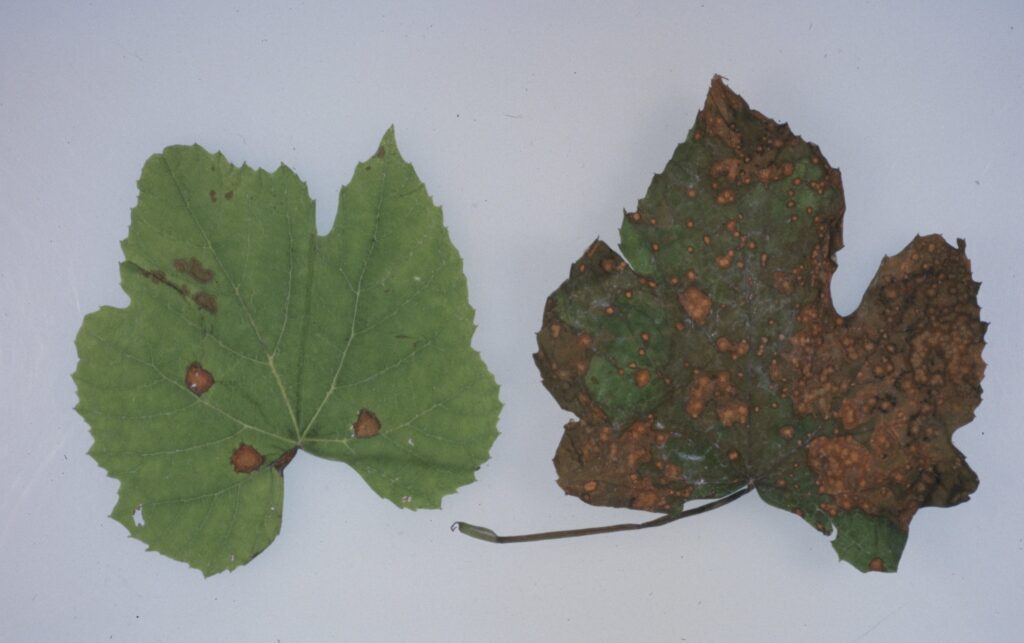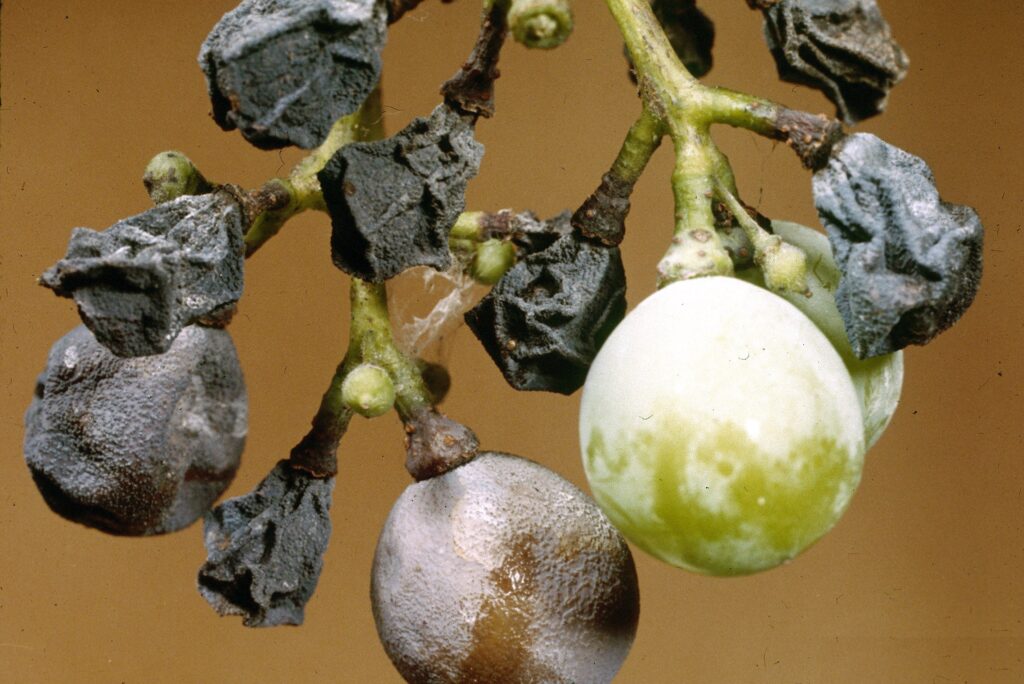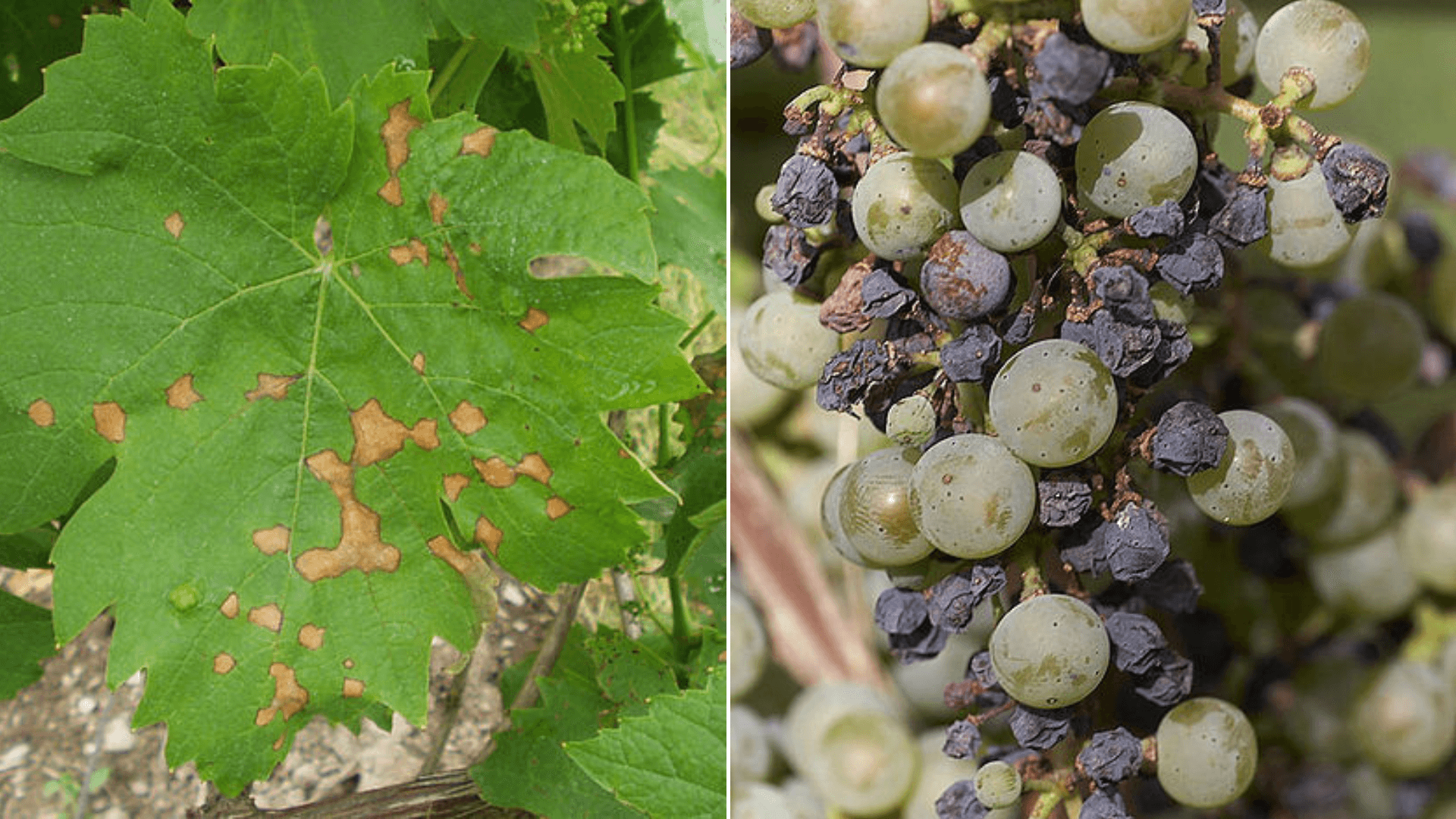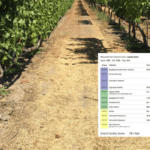Black rot is one of the most important grape diseases, and it is caused by the fungus Guignardia bidwellii. It originated from Northern America, but can now be found in Europe, South America, and Asia. The fungus appears in warm and humid climates and can cause significant economic damage. It can infect all young green parts of the plant but causes the most damage when it appears in fruits.

Symptoms of Black Rot
Symptoms of the black rot infection appear approximately 2 weeks after the primary infection. On leaves, the infections first appear as small brown circular spots, which can enlarge and develop light brown centres with dark margins.
After a few days, numerous tiny black fungal fruiting structures called pycnidia develop. The disease can develop only on young leaves; older ones are resistant to it. Black rot symptoms can also appear on shoots, petioles, and tendrils as brown to black irregular lesions. The fungus also infects berries, usually while they are still green. On berries, infection is first seen as light brown spots that eventually become dark brown and cover the entire berry. Infected berries shrivel and become black mummies.

Disease cycle of Black Rot
The black rot fungus overwinters in black mummies, on the ground, fallen leaves, and infected shoots. In the spring, ascospores release infected fruits with rain, which are then dispersed by water and the wind. These ascospores initiate the disease cycle and cause primary leaf and blossom infections. Infections depended on the length of the leaf wetness period and air temperature during that period. In favourable environmental conditions, spores’ conidia can cause secondary infection during the whole growing season.
Disease management
The most efficient way to control black rot is through a combination of good cultural practices and plant protection products. Good cultural practices include sanitation (removing all mummies and infected leaves from the vines), choosing resistant varieties, selecting a site with good air circulation, removing weeds and tall grass, and wise pruning of the vines. For a successful black rot management program, fungicides can be used, where the proper timing of spraying is essential. It’s crucial to control primary infection, which can prevent secondary infections later in the season. In case of infection, protective spraying has to begin before bloom through four weeks after the bloom. Fungicides should be used only when the risk of black rot infection is high, which results in fewer applications during the season and protection of the environment. To identify high-risk infection periods, disease prediction models, such as eVineyard, are essential.
Although black rot disease can cause a lot of damage in the vineyard, it’s not that hard to control it, especially if winegrowers are familiar with the characteristics of infection conditions and take good care of the vineyard.
Winegrowers, what are your experiences with black rot fungal disease? Let us know in the comment below!
Sources:
- Stephen M. Ries. Black Rot of Grapes. 1999. Report on Plant Diseases No. 703. University of Illinois, University of Illinois Extension, Integrated Pest Management (online).
- Nicole A. Ward & Cheryl A. Kaiser. Black Rot of Grape; Plant Pathology Fact Sheet. 2012. University of Kentucky, Cooperative Extension Service.
- Wayne F. Wilcox. Black rot Guignardia bidwellii (Ellis) Viala and Ravaz. 2003. Disease Identification Sheet No. 102GFSG-D4; Cornell University, Cornell Cooperative Extension.
- Featured images by Daniel Molitor via Wikimedia Commons





6 responses to “Black Rot of Grape (Guignardia bidwellii (Ellis))”
Wonderful posts posted! Very cool ideas. Awesome effort!
Thank you for your comment! Feel free to read also other posts.
i am looking for a type a fungicide that would be pre-bloom. I have read many but not sure of their success. mancozeb I think is the best then switch to Captans after bloom. Funny how this area is not covered successfully for the home grower.
Hello Berry, thank you for your question. Given that black rot needs moisture for its development, I would advise you first to make use of good cultural practice – make good air circulation and remove all weeds and tall grass during the growing season – before you decide to spray your vines. If you believe that you really need to use pesticides then yes as you already point it out mancozeb provide a good protection. You can also use myclobutanil or maybe also the strobilurin fungicides, please go to a hardware store or fungicide distributor and ask for fungicides that are available for home growers. However, since you are a home grower I would go for more organic control (copper products, etc.).
we have 10 acres of 25 different wine grapes of varied ages. we bought it 1 year ago. this year it seems they all have black rot. buss and leaves looked great at first….now I’m fighting this. I have sprayed 3 times with bonide without luck. Also the previous owners had left all the tubes on the plants, even the older ones. Can these be saved
thanks
Rasa
Hello Rasa, the ideal conditions for black rot infection are temperatures between 70°F to 80°F and leaf wetness, while the availability of primary inoculum peaks around bloom and drops off dramatically post-bloom. Therefore the timing of fungicide application is crucial. You did not mention in which growth stage are your vines, where are you located, which part of the plants are infected, only leaves? It’s recommended (if weather conditions are favorable for infection) to start applying protectant fungicides such as sulfur, copper, or mancozeb shortly before bloom and repeat at the intervals recommended on the label until approximately 4-6 weeks post-bloom. Thorough coverage is important. However, later infections may also be managed by systemic fungicides. As the sanitation of the vineyard is the most efficient way to control black rot, I suggest you consider this as well (don’t forget about it at winter pruning). In a small planting removal of infected fruit as it is discovered during the growing season is also an excellent way to limit the amount of inoculum.